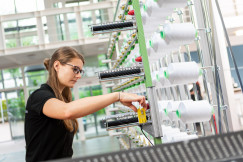News
14 November 2025
The reports on best practices and pledges from the EU Textiles Ecosystem Platform are out now!
News
14 November 2025
Ecosystem's readiness to support EU strategic autonomy and defence efforts
Infrastructure
Investments and funding
+23 more
Login / create an account to be able to react
-
16
Discover how Europe’s textiles ecosystem is driving sustainability and innovation. Two new reports on the EU Textiles Ecosystem Platform reveal the pledges shaping the Transition Pathway and showcase ten best practices delivering real impact across the value chain. From circular business models to resource-saving technologies, these insights highlight the collaborative efforts building a competitive and resilient future.
Topics
Albania
Armenia
Austria
Belgium
Bosnia and Herzegovina
Bulgaria
Croatia
Cyprus
Czechia
Denmark
Estonia
EU-27
Finland
France
Georgia
Germany
Greece
Hungary
Iceland
Ireland
Italy
Kosovo
Latvia
Liechtenstein
Lithuania
Luxembourg
Malta
Moldova
Montenegro
Netherlands
North Macedonia
Norway
Poland
Portugal
Romania
Serbia
Slovakia
Slovenia
Spain
Sweden
Switzerland
Türkiye
Ukraine
Other
Academic / Research and VET Institutions
Business Support Organisation
Company with 250 or more employees
Cluster Organisations
Consumer Organisations
Cultural and Heritage Organisations
Destination Management & Marketing Organisations
EU Institutions
Financial Institutions and Investors
Industry Associations and Chambers of Commerce
International Organisations
Local Authorities
Media / Journalist Organisations
National authorities
Networks and Federations / Confederations
NGOs / Non-profits
Notified Bodies
Regional Authorities
SMEs (a company with less than 250 employees)
Social Economy Entity
Trade Unions
Other
-
Transition Pathway's building blocks
-
-
Ecosystem's readiness to support EU strategic autonomy and defence efforts
-
Infrastructure
-
Investments and funding
-
R&I, techniques and technological solutions
-
Skills
-
Social dimension
-
Sustainable competitiveness
-
Regulation and public governance
-
-
Industrial ecosystems
-
-
Cultural and creative industries
-
Digital
-
Energy intensive industries
-
Energy-renewables
-
Proximity and social economy
-
Retail
-
Textile
-
-
Textiles ecosystem areas
-
-
Fibres, yarns and fabrics
-
Apparel and clothing accessories
-
Household/interior textiles
-
Technical textiles
-
Leather and fur
-
Footwear
-
Research and Innovation
-
Technology and Machinery
-
Waste management, reuse and repair
-
Business support and Communication
-
Not area specific (interested in more than one of the above)
-
Share
What are stakeholders across the EU Textiles Ecosystem striving to achieve, and which innovative practices are already shaping the future? These answers are now available in two newly published reports on the EU Textiles Ecosystem Platform, offering a comprehensive look at commitments and actions driving the ecosystem’s transformation.
Pledges shaping the Textiles Ecosystem’s Transition Pathway
Sustainable competitiveness lies at the heart of the shared story revealed by the Report on Stakeholder Pledges. It brings together 79 pledges from 20 organisations across 10 EU Member States and Switzerland, covering all eight building blocks of the Transition Pathway and addressing 30 of its 50 specific actions.
The largest share of pledges focuses on the action areas of Sustainable Competitiveness (37%), followed by Research and Innovation and Technological Solutions (20%), and Regulation and Public Governance (15%). These figures underline the strong emphasis of pledge-takers on building a competitive and future-ready textiles ecosystem.
Commitments range from circularity and resource efficiency to skills development and infrastructure, reflecting the determination to deliver a greener and more resilient future. Stakeholders include networks and federations, large companies, SMEs, academic institutions, and NGOs, demonstrating the collaborative nature of this transition. Geographic concentration in Italy and Belgium highlights opportunities for broader engagement across Europe.
Good practices implemented in the textiles ecosystem
The Report on Best Practices showcases ten pioneering initiatives that demonstrate how ambition translates into measurable impact. From advanced recycling hubs in the Prato Textile District to VEJA’s socially responsible supply chain and Nudie Jeans’ repair and reuse model, these cases illustrate the creativity and collaboration driving change.
Other highlights include breakthroughs in leather tanning that cut water and chemical use, and partnerships promoting gender equality and fair working conditions. Each example offers practical insights and replicable models for organisations across the value chain.
Together, these publications tell a story of progress and partnership. They provide inspiration, recognise the contributions of diverse actors and encourage further engagement, particularly from SMEs, which play a vital role in the ecosystem’s transformation.
Comments (0)
Related content
See also
EU channels €207 billion towards Digital Decade goals
- Categories
- Infrastructure Investments and funding R&I, techniques and technological solutions +28 more
European Commission unveils strategy to simplify and strengthen the EU Single Market
- Categories
- Infrastructure Investments and funding R&I, techniques and technological solutions +28 more
Welcome to the Skills and Talent Community Workspace!
- Categories
- Infrastructure Investments and funding R&I, techniques and technological solutions +28 more




